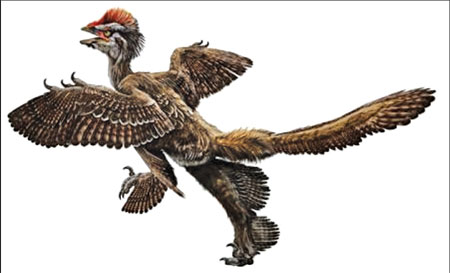
New evidence on wing evolution
Birds may be descendants of non-avian dinosaurs. We are always
fascinated by the birds, a unique species of animal that can fly and
also is covered in feathers. Scientists always believed they may have
descended from avian s that lived in the times of the dinosaurs.
However, ,today evidence is mounting that modern birds descended from
gliding, feathered non-avian dinosaurs. Two dinosaurs could be
candidates for the bottom of the bird family tree, and each helps to
reveal how feathers first evolved.
"The oldest known feathered dinosaurs would be Anchiornis (155
million years ago) and Epidexipteryx (between 152 million and 168
million years ago)," Yale University paleontologist Nicholas Longrich
told Discovery News. "Feathers seem to have appeared initially for
insulation. Basically they start out as down, and later are used to make
wings."
|

An artist's impression of Anchiornis huxley |
For a study published in the latest Current Biology, Longrich and
colleagues Jakob Vinther and Anthony Russell examined fossils of
Anchiornis huxley and of Archaeopteryx lithographica, a Jurassic species
that could be the world's oldest known bird.
"Where dinosaurs end and birds begin is a bit arbitrary," Longrich
explained. "There's no clear cutoff that separates one from the other.
"That's the nature of evolution; things gradually change from one
thing into another."
The scientists found that the wing feathers of Archaeopteryx and
Anchiornis were similar, but not identical. The variations between the
two appear to represent early experiments in the evolution of the wing.
Archaeopteryx had multiple layers of long flight feathers. In
contrast, the dinosaur Anchiornis had an abundance of simple, strip-like
feathers that overlap, somewhat similar to the feathers on penguins.The
design and arrangement of Anchiornis and Archaeopteryx wing feathers
probably hindered liftoff. Multiple overlapping layers of long wing
feathers would have complicated feather separation, minimizing the
bird's ability to overcome drag on the upstroke. By contrast, the wings
of modern flying birds typically have a single primary layer of easily
separated long feathers overlain by short feathers."Modern birds have
the ability to separate their wing feathers sort of like a Venetian
blind," Longrich said. "This allows them to raise the wing rapidly, and
seems to be critical to flapping flight at low speeds."
"The feather arrangement in Archaeopteryx and Anchiornis wouldn't let
them do this," he added, "so it may have made takeoff from the ground
and flapping at low speeds more difficult." Gliding, however, must have
been a lifesaver back in the dinosaur day, when huge terrestrial
carnivores were stomping around.
"Gliding is a fast way to move from tree-to-tree. Instead of climbing
down one tree and running up the next, you just glide quickly from one
to the other," Longrich explained.
"I would imagine that the dinosaurian ancestors of birds were living
in the trees," he noted, "probably to find food-like insects, lizards
and mammals, and to avoid becoming food for other dinosaurs." Longrich
and his colleagues believe that the wing feather arrangement seen in
modern birds may have evolved within a period spanning a few tens of
millions of years and then remained largely unchanged for the past 130
million years.In terms of this short versus long timescale, Longrich
compared it to the evolution of human-constructed aircraft, which
started with some years of experimentation before settling into a basic
design that's just been fine-tuned during more recent years.
"Birds hit on a workable design about 130 million years ago, and it's
been difficult to improve upon it," he said.
Birds benefited from both this and their small size 65 million years
ago, when the larger non-avian dinosaurs bit the dust. Xu Xing, one of
the world's leading paleontologists, is a professor at the Institute of
Vertebrate Paleontology and Paleoanthropology at the Chinese Academy of
Sciences. He told Discovery News that the determination about ancient
versus modern feathers and wings "is definitively a significant
discovery."The study "has greatly improved our understanding of wing
evolution," Xu continued. "(The authors) demonstrate that there are
unusual wings near the dinosaur-bird transition, though more data is
needed to confirm the claim that it is directly related to the origins
of avian flight. |



